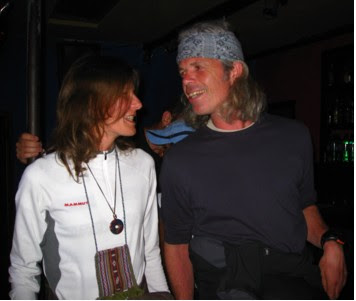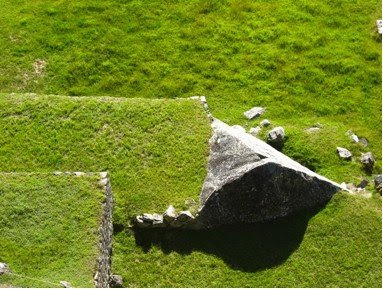We start our trek

Salkantay Mountain.

This is a hairless dog native to the Andes. It keeps warm because it has a higher body temperature.
May 4, 2009
- 5:30 am depart Cuzco
- 8:00 am arrive Mollepata
- 8:30 am trek
- 12:45 pm Lunch
- 5:00 pm arrive camp
May 5, 2009
- 6:00 am breakfast
- 7:45 am depart by horse
- 12:00 pm Salkantay Pass 4700 masl
- 1:20 pm lunch: Andenes Arayanic
- 5:30 pm arrive Chaullay
There are personal stories of individuals overcoming physical, spiritual or personal challenges and how they were subsequently changed. This is not one of them.
I started the Salkantay Trail to Machu Picchu on Monday. But I was already not feeling well. I had been on a Sacred Valley tour on Sunday and I had felt feverish the whole day with some slight diarrhea. I don’t know if it was due the alpaca I had had the night before or that it was a heavy meal while still adjust to the high altitude (3326 masl), but I was slumping around the entire day.
I didn’t feel well on Monday morning, but I got up at 3:30 am to for the 4:30 pick up. I was actually not feverish but still groggy and slow. The day started well enough with a light breakfast and the start of our trek on a cool, sunny morning from Mollepata. We had lunch and our trek continued its ascent. I was not feeling well by the late afternoon as I felt all my blood go to my lungs while my stomach felt like a brick—I was not digesting my food well. I had stomach problems. The last stretch of the trail I was huffing and puffing at 3900 meters above sea level.
That evening we were all exhausted with little appetite and no energy. After dinner, Darwin our trek leader, explained the trek for the following day. It would be the hardest as the ascent would be to 4600 masl in about 3 hours. We had the option of renting a horse for the ascent if we didn’t feel up to it.
That evening I spoke to Barbara, my tent mate, about climbing in high altitude. She explained that altitude sickness is when you have a headache, loss of appetite and vomiting. I had a headache and no appetite but it was hard to judge whether a hike on my power would delay the rest of the group. She felt that I could do it as long as I went very slow and climbed.
The following I spoke to Darwin about my situation. I didn’t feel I had altitude sickness. I just had a slight headache and I got out of breath. He explained that my tour company had a provision for a horse if I wanted it. I told him that I would prefer to climb the mountain on my own power--as a testament to myself. But I also recognized that I was very new to high altitudes and would defer to his opinion if he thought it best that I take a horse. “You have seven years experience and you can probably determine which individuals are candidates for taking a horse.” He looked at me and said, “I think you should take the horse.” I was afraid of that.
But as I mounted that morning, I felt I was copping out. I saw other individuals, older and some in less physical shape than I, climbing on their own power. While the decision was probably a wise decision, I regretted it, as it was a lost opportunity to demonstrate to myself my personal best.
On the other hand, life has its decisions of regret, so this was an opportunity to hold in mind fpr the future when I am faced with a challenge to stretch myself and accomplish a goal.



Darwin teaching us about Andean culture and stories.






Eddie, our trek assistant.
Fortuitousness
When I arrived In Cuzco a young girl was selling woolen caps. She was so charming and I was in a good mood, that I bought one for s/ 10 soles ($ 3.30). The following day on the tour of the Sacred Valley, we stopped in C’orao, a small artisan village, where I bought a nice alpaca sweater or chompa (jumper) as they call them here. I noticed that alpaca doesn’t make me itch or sneeze as wool does.
Little did I know how necessary they would be on the Salkantay Trail, especially on the first night and second day when we were at 3600+ masl. When I arrived in Puno (3800 masl) and La Paz (3700 masl) and later in frigid Uyuni, where I bought gloves and a scarf (3675 masl), I was glad to have them. I was reluctant to buy any more clothes than necessary, but as luck would have I was so happy I did.
May 6, 2009
- 6:45 am breakfast
- 7:45 am depart
- Bridge Collpachaca
- Bus to Sahayaco playa
- Lunch
- Bus to Sta Teresa
- Hot Springs
- Dinner
- Club/Bar
- Camp for the night



- 8:00 am breakfast
- 9:00 am Trek
- 12:00 pm hidroeléctrica
- 4:00 pm Aguas Calientes
- Dinner: Sabor Andino

- 4:25 am Trek to Machu Picchu
- 5:40 am Gate
- 9:00 am Palace Terraces
- 10:00 am Huayna Picchu
- 12:30 pm Sun gate
- 2:00 pm Inka Bridge
- 3:30 pm depart Machu Picchu
- 5:30 Train Station
Salkantay Trail: afterword
What was amazing about the Salkantay Trail we took is how well we all got along. Really.
I don’t know if we all liked each other, but there were no issues between individuals. But we got together for each others’ needs, for happy hour and at a bar. To put a bunch of strangers together for five days can be a bit unpredictable, but the fact that we had not problems among ourselves is quite fortunate. Darwin’s experience, knowledge and easy going manner made for a pleasant trek. Darwin was especially patient in keeping us together and as we didn’t all get up at the appointed times; Eddie, his assistant, was pivotal in helping out.
May 9, 2009
- Errands
- United Mice: Inka Pachacuteq
- Museo Histórico Regional
- Museo Arte Popular
- Sacayhuaman
- Mass @ La Compañía
- Dinner w/ Barbara
May 10, 2009
- Market
- Eddie
- Curandero
- Centro de Artesanias
- Plaza de Armas
- Centro de Qosco de Arte Nativo
- 10:00 pm depart Cuzco



- Market
- Eddie
- Curandero
- Centro de Artesanias
- Plaza de Armas
- Centro de Qosco de Arte Nativo
- 10:00 pm depart Cuzco



























No comments:
Post a Comment